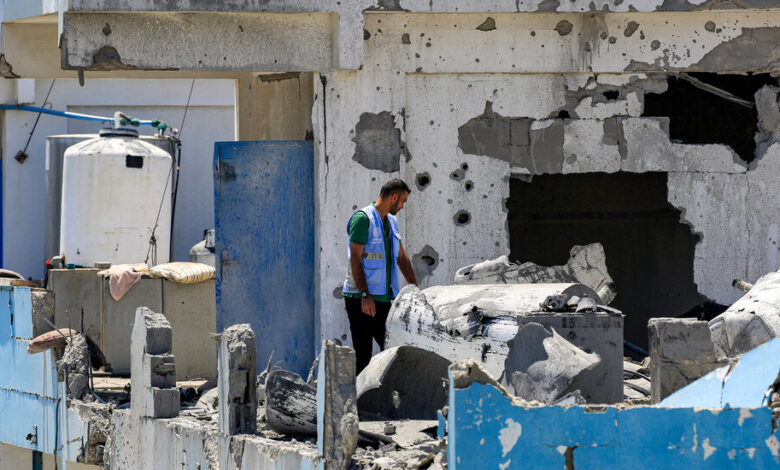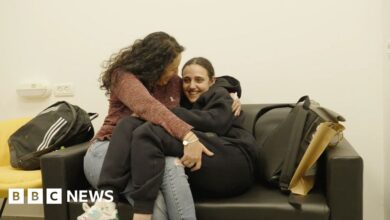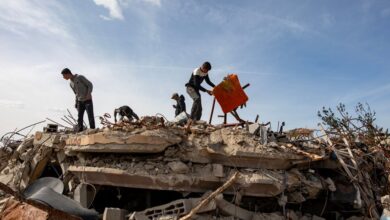Middle East crisis: Israel strikes in central Gaza after deadly attack on shelter

As dawn broke Thursday, Haitham Abu Ammar sifted through the rubble of the school that had become a shelter for him and thousands of other displaced Gazans. For hours, he helped people piece together the details of their loved ones.
Abu Ammar, a 27-year-old construction worker, said: “The most painful thing I ever experienced was picking up those pieces of meat with my hands. “I never thought I would have to do something like that.”
Early Thursday morning, Israeli airstrikes hit the school complex, killing dozens of people – among them at least nine militants, the Israeli military said.
During that day, bodies and mangled limbs were recovered from the rubble wrapped in blankets, stacked on truck beds and taken to Al Aqsa Martyrs Hospital, the last major medical facility still still active in central Gaza.
The Israeli military described the airstrike as meticulously planned. Rear Admiral Daniel Hagari told reporters that Israeli forces had been watching the militants in a shelter behind the school for three days before opening fire.
“The Israeli army and Shin Bet have found a solution to separate the terrorists from those seeking shelter,” he said.
But reports from doctors at home and abroad, as well as a visit to the hospital by The New York Times on Thursday afternoon, make clear that civilians have also died.
Outside the hospital morgue, crowds gathered to cry and pray for those who died. The hospital hallways were packed with people begging for help, or at least a little comfort.
A young girl with a bloody leg shouted: “Mom! Mom!”, as her sobbing mother followed her through the hospital hallway.
The exact number could not be verified, but Gaza’s Health Ministry said that of about 40 people killed in the attack, 14 were children and nine were women. Later in the day, the Associated Press reported other figures, saying at least 33 people had died, including three women and nine children, citing the hospital morgue.
Al Aqsa Martyrs Hospital has become a symbol not only of the devastating loss of life in central Gaza but also of the growing sense of desperation among Gazans trying to find a place that is still safe there.
Over the past few weeks, the area has seen a growing number of people fleeing another Israeli offensive, this time in the southern city of Rafah. Before that offensive began, Rafah was the main refuge for civilians, at one point holding more than half the population of the Gaza Strip.
Then on Wednesday, Israel announced that it had begun a new operation against Hamas militants in central Gaza – where many Gazans fleeing Rafah have arrived.
The attack on the school complex took place early the next morning, around 2 am. It struck a building in a complex run by UNRWA, the main United Nations aid agency for Palestinians in Gaza.
Since the Israeli attack on Gaza began in October, in retaliation for the Hamas-led attack on Israel, such schools have been used to shelter Gazans forced to leave their homes due to fighting. Israel says Hamas hides its forces in civilian facilities such as schools or hospitals, a charge the group denies.
Medical staff said that in the past two days of the new military campaign, Al Aqsa received 140 dead and hundreds of wounded.
“It was complete chaos, because we had mass casualties,” said Karin Huster, a nurse with the international aid group Doctors Without Borders, who was working as a medical coordinator at the hospital. , but there are increasingly fewer medical supplies to treat them.” .
During The Times’ visit to Al Aqsa, doctors could be seen pushing through crowds of panicked people trying to get to the operating room, delayed by overcrowding. In the confusion, Ms. Huster said, doctors sometimes rushed seriously injured people into the operating room, wasting vital time for those who still had a chance to survive.
Ms. Huster said the majority of people she met in recent days were women and children.
By early Thursday afternoon, after burying a friend he had pulled from the rubble of the school complex, Mr. Abu Ammar found himself again at the hospital.
This time, he was accompanied by his friend’s brother, whom he was trying to squeeze into the hallway near the entrance. The brother’s face was cut by shrapnel and there was a deep cut on his right leg.
But he wasn’t the only one desperately in need of help.
Around them were injured people, some lying in pools of their own blood, others lying on beds calling for help. A man whose face was blackened by burns and dust from that morning’s explosion begged two relatives accompanying him to use a piece of cardboard that they waved in front of him.
The scene of the dead in the morgue was as chaotic as that of the living. Bodies lay everywhere, while relatives crowded, crying and screaming nearby. The strong smell of blood.
The crowd outside the morgue dwindled as bodies wrapped in blankets — shrouds were in short supply — were lifted into pickup trucks for burial. Relatives and friends line up to pray before the dead are taken away. Even passersby stopped to participate.
“When is it too much?” Ms. Huster said. “I don’t know how to express this to shock people. Where did humanity go wrong?”
June 7, 2024
:
A previous version of this article incorrectly mentioned Karin Huster’s role. She is a nurse with Doctors Without Borders but does not work in a hospital. She said that most of the people she met in the past few days, but not most of the people she treated, were women and children.
How we handle edits




